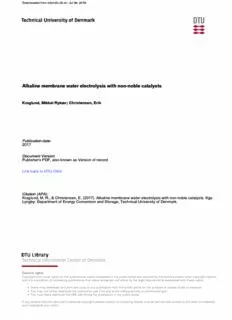
Alkaline membrane water electrolysis with non-noble catalysts PDF
Preview Alkaline membrane water electrolysis with non-noble catalysts
Downloaded from orbit.dtu.dk on: Jan 11, 2023 Alkaline membrane water electrolysis with non-noble catalysts Kraglund, Mikkel Rykær Publication date: 2017 Document Version Publisher's PDF, also known as Version of record Link back to DTU Orbit Citation (APA): Kraglund, M. R. (2017). Alkaline membrane water electrolysis with non-noble catalysts. Department of Energy Conversion and Storage, Technical University of Denmark. General rights Copyright and moral rights for the publications made accessible in the public portal are retained by the authors and/or other copyright owners and it is a condition of accessing publications that users recognise and abide by the legal requirements associated with these rights. Users may download and print one copy of any publication from the public portal for the purpose of private study or research. You may not further distribute the material or use it for any profit-making activity or commercial gain You may freely distribute the URL identifying the publication in the public portal If you believe that this document breaches copyright please contact us providing details, and we will remove access to the work immediately and investigate your claim. Mikkel Rykær Kraglund Alkaline membrane water electrolysis with non-noble catalysts PhD Thesis July 2017 Title: Alkalinemembranewaterelectrolysiswithnon-noblecatalysts Author: MikkelRykærKraglund E-mail: [email protected] Principalsupervisor: ErikChristensen,SeniorResearcher,DTUEnergy E-mail: [email protected] Co-supervisors: JensOlufJensen,Professor,HeadofSection,DTUEnergy E-mail: [email protected] DavidAili,Researcher,DTUEnergy E-mail: [email protected] AlekseyNikiforov,DevelopmentEngineer,DTUEnergy E-mail: [email protected] Dateofsubmission: Submitted31st ofJuly,2017 Defended13th ofOctober,2017 Revisedon19th ofOctober,2017 DepartmentofEnergyConversionandStorage SectionforProtonConductors TechnicalUniversityofDenmark Kemitorvet,Building207 2800Kgs. Lyngby Denmark www.energy.dtu.dk Tel: (+45)46775800 ISBN:978-87-92986-65-8 ”Yes,myfriends,Ibelievethatwaterwillonedaybeemployedasfuel, that hydrogen and oxygen which constitute it, used singly or together, will furnish an inexhaustible source of heat and light, of an intensity ofwhichcoalisnotcapable.” -JulesVerne1874,TheMysteriousIsland Preface ThisthesisissubmittedincandidacyforaPh.D.degreefromtheTechnicalUni- versityofDenmark(DTU).Theworkhereinwasconductedover3yearsrunning from August 2014 to July 2017. The work has primarily taken place at Section for Proton Conductors, at the Department of Energy Conversion and Storage, supervisedbyErikChristensen,JensOlufJensen,DavidAiliandAlekseyNiki- forov. A part of the work, from September 2016 to December 2016, was con- ducted at Forschungszentrum Jülich (FZJ), Germany, at the Institute of Energy and Climate Research, IEK-3: Electrochemical Process Engineering, in collabo- rationwithMarceloCarmo. TheprojectwasinternallyfundedatDTUEnergy,partiallybyinternalprojects PorouZandTTJOEL. MikkelRykærKraglund July2017 i Abstract As renewable energy sources reach higher grid penetration, large scale energy storage solutions are becoming increasingly important. Hydrogen produced withrenewableenergybywaterelectrolysisiscurrentlytheonlyoptiontosolve this challenge on a global scale, and green hydrogen is essential for the decar- bonization of the transportation and industrial sector required to limit climate change. Electrolysisdonewithanalkalineelectrolyteisacheap,proven,andcommer- cially available technology, but the systems suffer from inefficiency and limited operating flexibility. The work herein seek to address these issues by introduc- ing alkaline polymeric membranes and efficient electrodes based on novel ma- terials. Polymer electrolyte membranes with sufficient OH–-conductivity enable a drasticreductionoftheelectrodespacing,whichleadtoimprovedohmicprop- erties enabling operation at higher current density. This, combined with better gas separation properties and a higher operating flexibility, have the prospects of significantly reducing the capex and opex of electrolysis systems, and the cost of green hydrogen. Towards this goal, membranes based on poly(2,2’-(m- phenylene)-5,5’-bibenzimidazole) (m-PBI) as well as poly(2,2’-(m-mesitylene)- 5,5’-bibenzimidazole)(mes-PBI)wereinvestigatedaselectrolyteforalkalineelec- trolysiscells. PBI membranes were equilibrated with aqueous KOH and applied as sep- arator, and polarization data from cells at 20-25 wt% KOH using these mem- branes showed improved ohmic behaviour over cells with conventional porous separators. Thiswasstrikinglyclearwhencombinedwithactiveelectrodeswith Raney-nickel-basedcoatings. Withthin40µmm-PBImembranes,Raney-nickel- ◦ molybdenum cathodes and nickel anodes, cells operated at 80 C with 24 wt% iii KOH (aq) achieved 1000 mA cm(cid:0)2 at 1.7 V and 2800 mA cm(cid:0)2 at 2.0 V. Elec- trochemical impedance spectroscopy data showed a 6-fold reduction in ohmic cell resistance compared to conventional materials. Albeit good performance, ex-situcharacterizationanddurabilitytestsshowedthatpolymerbackboneand membrane stability remained a problem under conventional operating condi- tions. To accompany novel membranes in alkaline electrolysis, electrodes can be employed in a zero-gap configuration. This enable different electrode concepts thanusedincommercialsystems. Inspiredbyrecentliterature,nickel-ironbased anodes,andnickel-tinaswellasnickel-molybdenumcathodeswereinvestigated in half cell tests. The materials were applied as coatings on nickel foam and showed improvements in the order of 150-300 mV over reference nickel mate- rials at room temperature, depending on the specific electrode and electrolyte concentrationused. In a secondary approach, electrodes were prepared using powder and poly- mericbinders. Usingnickelpowderwithm-PBIbinderinanickelfoamascath- ode, a reduction in cell overpotential of more than 200 mV was achieved com- paredagainstapristinenickelfoamcathode. iv Resumé Iforbindelsemedatvedvarendeenergikilderopnårenstørreudbredelsebliver energilagringistorskalagradvistmerevigtigt.Brintproduceretvha.vedvaren- de energi fra elektrolyse af vand er i øjeblikket den eneste mulighed til at løse denne udfordring på en global skala, og grøn brint er essentielt for at afkarbo- niseretransport-ogindustrisektorene,hvilketernødvendigthvisklimaændrin- gerneskalbegrænses. Elektrolysemedalkaliskelektrolyterenbillig,gennemtestet,ogkommercielt tilgængelig teknologi, men den nuværende teknologi lider under ringe effekti- vitet og begrænset driftsfleksibilitet. Arbejdet beskrevet i dette værk forsøger atimødekommedisseproblemervedatanvendealkaliskepolymer-membraner fremforporøseseparatorer,samtvedatanvendeelektroderbaseretpånyema- terialerudenædelmetaller. Vedbrugafpolymer-elektrolyt-membranermedtilstrækkeligOH– lednings- evneerdetmuligtatreducereafstandenmellemelektroderneienelektrolysecel- ledrastisk.Dettemedførerbedreohmiskeegenskaberogåbneropfordriftved højere strømtætheder. Kombineret med bedre gas adskillelses egenskaber og størredriftsfleksibilitetgiverdetudsigttilatnedsætteanlægs-ogdriftsomkost- ninger,ogdermedreducereomkostningernevedatproduceregrønbrint.Forat opnådetteermembranerbaseretpåpoly(2,2’-(m-phenylen)-5,5’-bibenzimidazol) (m-PBI),samtpoly(2,2’-(m-mesitylen)-5,5’-bibenzimidazol)(mes-PBI)blevetun- dersøgtsomelektrolyttilalkaliskeelektrolyseceller. PBImembranerneblevaktiveretistærkKOH(aq)opløsningoganvendtsom separator.Polariseringsdatafracellermeddissemembranerved20-25wt%KOH udviserforbedredeohmiskeegenskaberiforholdtilcellermedtraditionellepo- røseseparatorer.Dettevarisærtydeligtnårmembranerneblevkombineretmed aktiveelektroderbaseretpåRaney-nikkelbelægninger.Medtynde40µmm-PBI v
Description: